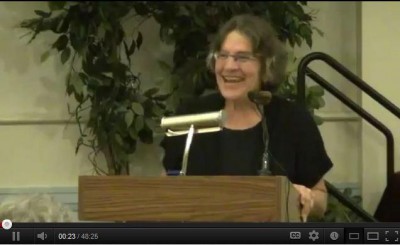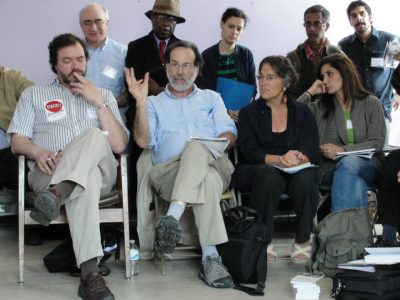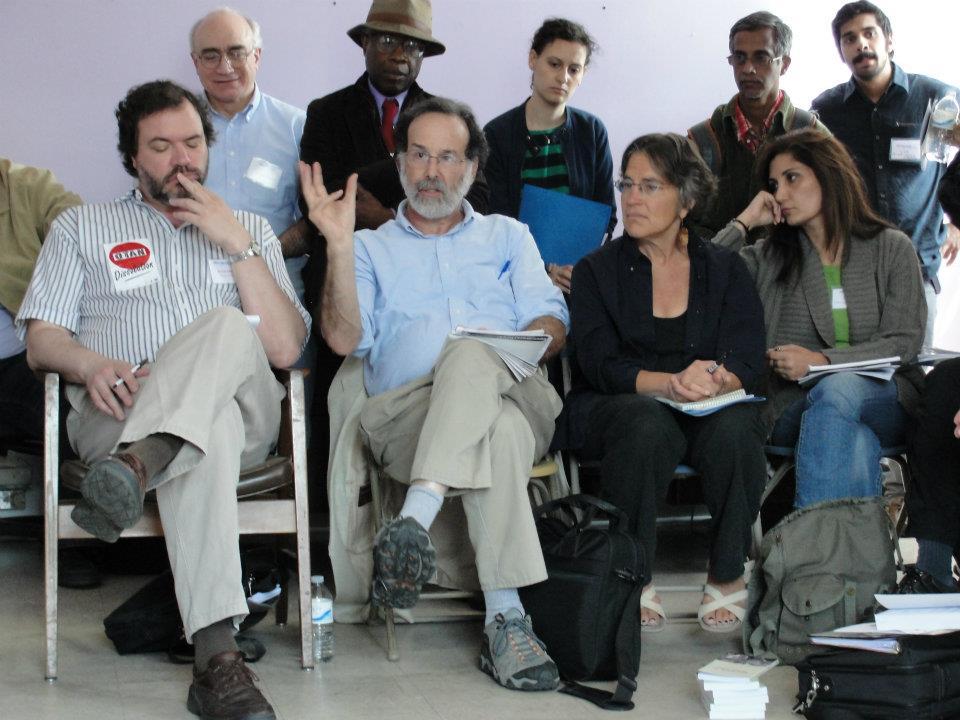The summer heat waves, thunderstorms and extreme weather (like the hurricane-like derecho storm here in Washington) seem to have slightly eased for the moment. But the wars and occupations and threats of new wars haven’t abated very much.
Before I get to the analysis part, just a quick reminder of what we are all up against. Last week at one of the regular State Department briefings, spokeswoman Victoria Nuland drew the press’s attention to the just-released Human Rights Watch report on torture and detention carried out by the Syrian government. Asked whether the State Department believes the report to be credible, the spokeswoman went on:
MS. NULAND: We have no reason to believe that it is not credible. It’s based on eyewitness accounts, and they’re reporting from a broad cross-section of human rights figures inside Syria.
QUESTION: So the next time Human Rights Watch comes out with a report that’s critical of Israel for its treatment of the Palestinians, I’ll assume that you’re going to be saying the same thing, correct, that you think that the report is credible, it’s based on eyewitness accounts? …
QUESTION: And you’re not going to say that it’s politically motivated and should be dismissed?
MS. NULAND: Matt, as you have made clear again and again in this room, we are not always consistent. (Full briefing — with a few more priceless comments — is here.)
IRAN – THREATS OF WAR CONTINUE
“Not consistent.” That would be the polite term for it, I suppose. As long as we’re talking about the State Department, one other issue came up regarding Iran. I asked in a recent blog post, “Is the State Department going rogue, or did it just forget how to spell?” Either way, we’re in a bit of trouble. Following the U.S.-Israel “strategic partnership” meeting, the State Department made odd claims of which nobody else in the administration seems to be aware, noting that the U.S. and Israel had addressed their concern that Iran is engaged in a “continued quest to develop nuclear weapons.” There was no explanation of why the conclusion of this U.S.-Israeli dialogue seems to fly in the face of the U.S. intelligence agencies’ actual position with regard to Iran’s nuclear program, which is that Iran not only does not have any nuclear weapons, and is not building a nuclear weapon, but that Tehran has not even made the decision about whether to build a nuclear weapon. (For the spelling question, take a look at the blog post).
In fact a recent Pentagon report stated clearly thatIran’s military strategy is actually defensive — it’s designed to “force a diplomatic solution to hostilities.” (To which my good friend Bob Naiman, of Just Foreign Policy, responded, “damn those sneaky Persians and their sissy diplomacy! Why won’t they stand and fight to death like real men on the field of open battle (where we have the overwhelming advantage) instead of running away like little crybabies to complain to Mommy inGeneva andNew York?”)

Sharing a good moment in New York City with the wonderful Grannies Peace Brigade. Watch the video of my talk on their YouTube page.
The threat of war in Iran remains, with Israeli pressure for military action continuing, and the U.S. imposing ever-harsher sanctions. At the moment I don’t think there will be an Israeli (or a U.S.-Israeli) military strike against Iran this year — but given the human, economic, political and human rights consequences, even a tiny possibility of such a strike is way too dangerous. I was in New York a couple of weeks ago to speak at an event organized by the wonderful Grannies Peace Brigade — one of my favorite groups. We talked about why the threat of war remains so dangerous, even though all the U.S. intelligence agencies, the secretary of defense, the national intelligence irector, and more, all agree on those points I just mentioned — that Iran doesn’t have a nuclear weapon, isn’t building a nuclear weapon, and hasn’t even decided whether or not it wants a nuclear weapon. It’s not about a real danger from Iran. It’s all about the politics. One of the main reasons this time is the role of Israel — where the prime minister and minister of defense are sticking to their military threats against Iran despite the fact that Israel’s own military and intelligence officials are also overwhelmingly against a military strike.
The New York talk also focused on the real reasons why Israeli political leaders see Iran as a threat. It’s not about some existential threat coming from a nuclear weapon Iran doesn’t have. It’s because Israel’s current monopoly of several hundred nuclear weapons at its Dimona plant and its second-strike capacity from new nuclear submarines obtained from Germany give Tel Aviv a huge strategic/military advantage in the region, even beyond its second-to-none military capacity. And Prime Minister Netanyahu is not prepared to be the Israeli leader on whose watch Israel loses its nuclear weapons monopoly in the Middle East. You can watch the video of me with the Grannies here.
I also participated in an interesting discussion on Iran on al-Jazeera’s “Inside Story,“ looking particularly at the dangers created by the recent escalation of both rhetoric and naval maneuvers by the U.S. and Iran in the Strait of Hormuz. That narrow waterway, through which 20 percent of the world’s oil traffic passes, is incredibly crowded. U.S. warships, minesweepers, and more are sailing in and around the strait, along with the U.S. Navy’s newest “floating forward base,” an old navy transport ship redesigned as an off-shore base from which marines, SEALS and other special forces can launch “counterterrorism” and other attacks. And beyond the naval assets, according to the New York Times, “[s]ince late spring, stealthy F-22 and older F-15C warplanes have moved into two separate bases in the Persian Gulf to bolster the combat jets already in the region and the [aircraft] carrier strike groups that are on constant tours of the area. Those additional attack aircraft give the United States military greater capability against coastal missile batteries that could threaten shipping, as well as the reach to strike other targets deeper inside Iran.” (Emphasis mine.)
Not surprisingly, Iran responded to that escalating U.S. military presence with moves of its own, including a recent military exercise in the strait. The danger, of course, beyond the possibility of intentional escalation, is the possibility of an unintended, accidental clash between, say, two small naval boats, one from the U.S. and one Iranian. Without a military-to-military communications system in place (something quite unlikely to be approved by either capital right now) there is no way of diffusing a small event before it escalates to something far more serious, and potentially spirals completely out of control. You can watch the Al-Jazeera discussion here.
SYRIA
While we keep working to prevent a war in Iran, the conflict in Syria is escalating. The International Committee of the Red Cross (ICRC) today announced that Syria is now facing a full-scale civil war. That’s important, because the ICRC, as the repository for the Geneva Conventions, is responsible for determining when the laws of war — what’s known as international humanitarian law — applies. By saying it’s a civil war, it means that all sides are bound by the Geneva Conventions regarding protection of civilians, treatment of prisoners, and more.
The conditions facing ordinary Syrians are dire, and the fighting has spread to the very center of Damascus, the capital. The one small bit of good news came a few days ago from the head of the UN observer mission, Norwegian General Robert Mood, who noted that his team “has been engaging in some localities to facilitate local dialogues between the parties as they seek to find a step by step way to build confidence and stop the negative spiral of violence. In this context, encouraging progress has been made by the parties in Deir Ezzor. We observe a significant reduction of violence and growing confidence in a possible step by step approach to stop the violence…. [T]he political dialogue has to be brought inside Syria and we have to build on the progress that we are seeing on the ground, noting in particular the encouraging process as we speak in Deir Ezzor. Through that dialogue, and lifting it to the national level, we will then achieve a cessation of violence…. [Y]ou need a tool on the ground that is more politically oriented, that is more flexible in use and able to build on local initatives, local engagement, that can facilitate the Parties’ will to go step by step in the right direction, as we are doing in Deir Ezzor, and from that we can go toward action on the national scale.”
This is particularly important as it seems to reflect a shift in the mission’s work. It has been relying almost entirely on the regime of Bashar al-Assad and the opposition forces based outside of Syria, primarily the Syrian National Council and the Free Syrian Army, most of whom refuse to negotiate until Assad is gone. By beginning to deal with the still-non-violent movement inside Syria, and the opposition forces inside who are prepared to negotiate, there is some hope that the UN team on the ground may be able to bring about what the Security Council has so far failed to achieve — a real ceasefire.
The mandate for Gen. Mood’s observer team expires this week, and the Security Council is about to vote on whether to extend its work. All sides agree it is important to keep the UN observers on the ground. But the U.S., so far, is refusing to support an extension of the mandate unless the Council moves under Chapter VII of the UN Charter, which includes approval of the use of military force as well as economic sanctions. This is a very dangerous move, as it has brought Washington and Moscow which (along with Beijing) rejects any UN authorization of outside military engagement, into a direct conflict. If the U.S. holds to its position, it is likely the Council will simply allow the mandate of the observer mission to expire, thus ending the one potential diplomatic move that seems to be achieving some results.
I wrote an extensive background piece on the conflict, called “Syria: No to Intervention, No to Illusions,” including a “who’s-who” of the forces at play in the uprising. It was published on the Mondoweiss website, among others. (A shorter version, “Only Diplomacy Can Stop the War,” was published at Al-Jazeera.)
THE ARAB SPRING CONTINUES — AND THE U.S. ISN’T HELPING

Iraq and Afghanistan vets from Iraq Veterans Against Against the War toss their combat medals back towards the NATO leaders at Chicago summit.
I did get to write about some good news from the Arab Spring. The elections in Egypt resulted in a mixed bag of results, with many Tahrir Square activists bitterly disappointed that the presidential choice came down to the old military vs. the old opposition. It’s still contested terrain, with Egypt’s military still challenging the elected parliament and president, but it’s a stunning reversal of the last 40 years that the military has to take into account the Egyptian people and their elected representatives!
The announcement by Egypt’s electoral commission that Muslim Brotherhood candidate Mohamed Morsi had won the run-off presidential election last week still generated a joyous party in Tahrir Square. But behind all the celebrating was a sober reminder that Egypt’s revolutionary process remains unfinished, and that its goals of freedom from dictatorship, of real democracy, and of human rights are still unrealized. Many supporters of the Muslim Brotherhood were celebrating that their candidate, whose organization had been banned for so many years, now holds the top seat of Egyptian power. For many others, the mood reflected less celebration of the candidate than relief that the threat of Egypt’s still powerful military rulers (still getting $1.3 billion annually in U.S. military aid) to reverse the popular vote in favor of their own chosen candidate Ahmad Shafiq, had not come to pass — and a commitment to continue the unfinished revolutionary process launched more than a year ago.
And interestingly, the “Think-Tanked” column at the Washington Post picked up my blog post in a look at how Egypt’s elections were being covered.
U.S. policy in the Middle East, and particularly toward the Arab Spring, were central to a fascinating conversation I had hosting Book TV’s “After Words” program on C-SPAN, in an interview with Fawaz Gerges. His new book on President Obama’s Middle East policy was the basis for lots of questions and good discussion.

Speaking at the NATO summit protest teach-in with Peace Action, Afghans for Peace, and anti-nuclear activists.
Of course broader components of U.S. policy aren’t so optimistic. I was in Chicago for the protests against the NATO summit meeting there, and the teach-ins and demonstrations were great. The march led by the young Iraq and Afghanistan vets of Iraq Veterans Against the War, after which 45 of them, one by one, tossed back their combat medals toward the meeting of the NATO commanders half a mile away, was particularly powerful.
But with the disproportionate percentage of U.S. tax money that flows to the Pentagon, the threat of greater U.S. reliance on military force instead of diplomacy remains a constant reality. Shortly after the summit I joined Amy Goodman for a discussion of NATO’s future on Democracy Now! On the program I talked about the problem of the hammer and the nail. If you’re a hammer, everything looks like a nail. If you’re NATO, everything looks like it needs military intervention. We have a lot of work to do.
PALESTINE-ISRAEL — DISCOURSE SHIFTING STILL
But while we’re talking about good news, there’s even some on Palestine. Just a couple of weeks ago the General Assembly of the Presbyterian Church USA voted to boycott all settlement-produced goods and to call on other nations to join a similar boycott. Earlier, the assembly had demanded a suspension of U.S. military aid to Israel. It was the latest victory in an eight-year campaign to bring the Church’s investment policies into line with its commitment to social justice. The proposal calling for divestment from specific corporations — Caterpillar, Motorola Solutions, and Hewlett-Packard — profiting from occupation and militarism, was ultimately taken off the table when a razor-thin majority (333 to 331 with two abstentions) approved a substitute motion calling for a vote on investment in Palestinian enterprises instead. That was unfortunate, but there is every reason to expect divestment to be back on the agenda in two years.
The overall process of the Presbyterians represents a huge victory in the struggle for Palestinian rights, and a huge step in the effort to delegitimize U.S. corporate support for occupation and apartheid. During the Presbyterian debate, it was notable that virtually none of the opponents of divestment even attempted to defend Israeli actions. The debate, ultimately, was not over whether Israel’s actions were wrong, but more simply, what the Presbyterians should do in response to those wrongs.
The Presbyterian effort followed important victories just days before. The powerful investment broker Morgan Stanley Capital International (MSCI) removed Caterpillar from its social responsibility index, followed 24 hours later by pension-fund giant TIAA-CREF’s decision to divest its more than $72 million of Caterpillar stock. The Quaker Friends Fiduciary Corporation has also divested $900,000 from Caterpillar.
Times have changed. The Presbyterian vote to boycott settlement goods, end U.S. military aid to Israel, and more, both reflects and moves forward that powerful change. I even got a letter to the editor published in the New York Times on those recent boycott-divestment-sanctions (BDS) victories.
I’ve been doing a bunch of speaking on this stuff lately. In Paris last month I participated in an international meeting at UNESCO, under the auspices of the UN Committee on the Exercise of the Inalienable Rights of the Palestinian People, as well as a following civil society meeting. During the diplomatic meeting, my presentation focused on the role of the UN and the importance of a UN-civil society partnership when traditional diplomacy fails. The video of that panel is here, you have to scroll down to Plenary III (my presentation starts about 15 minutes in). During the civil society meeting, I focused on the need to build a global movement to press governments to challenge U.S. domination of the Israel-Palestine diplomacy that has led to 21 years of failure, and to replace it with a UN-based diplomatic process based on international law and human rights, rather than existing power. The civil society meeting video is here, and you can find my presentation about 15 minutes into Part I.
And just last week I spoke at the Palestine Center’s intern lecture series, focusing on the role of global social movements in the non-violent struggle for Palestinian rights. That video is here.
